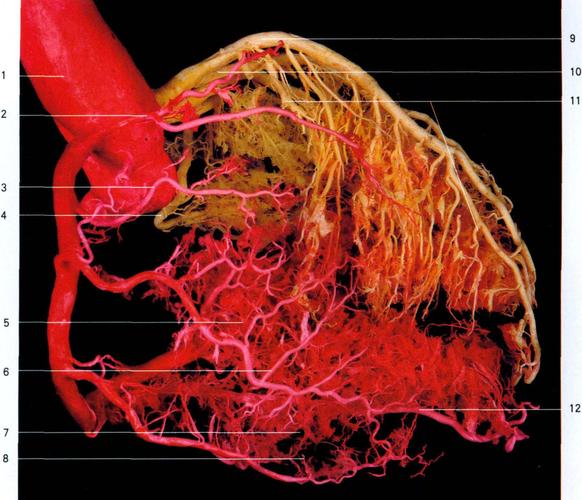Understanding the OM Branch of the Coronary Artery
The coronary arteries are vital to the health of your heart, as they supply it with the oxygen-rich blood it needs to function properly. One of these arteries, known as the OM branch, plays a crucial role in the circulatory system. In this detailed exploration, we delve into the anatomy, function, and significance of the OM branch of the coronary artery.
Anatomy of the OM Branch
The OM branch, also referred to as the obtuse marginal artery, is a branch of the left circumflex artery. It originates from the left coronary artery and typically runs in a curved path towards the outer side of the heart. The OM branch supplies blood to the posterolateral wall of the left ventricle and the adjacent part of the interventricular septum.The OM branch is approximately 1.5 to 2.5 centimeters in length and can be divided into three segments: the proximal, middle, and distal segments. The proximal segment is the widest and is often the site of atherosclerotic plaque formation, which can lead to coronary artery disease.
Understanding the anatomy of the OM branch is essential for diagnosing and treating conditions that affect this artery. Conditions such as coronary artery disease, myocardial infarction, and heart failure can all impact the OM branch and its function.
Function of the OM Branch
The primary function of the OM branch is to supply blood to the posterolateral wall of the left ventricle and the adjacent part of the interventricular septum. This blood supply is crucial for maintaining the heart’s pumping function and overall health.The OM branch also plays a role in the collateral circulation, which is the process of blood flow through alternative routes when the main blood vessels are blocked. In cases where the left circumflex artery is occluded, the OM branch can become a critical collateral vessel, ensuring that the heart muscle receives adequate blood supply.
Given its role in collateral circulation, the OM branch is of particular interest to cardiologists and cardiac surgeons. Understanding the function of this artery can help in developing better treatment strategies for patients with coronary artery disease.

Significance of the OM Branch
The OM branch is significant for several reasons:1. Risk of Atherosclerosis: The OM branch is susceptible to atherosclerosis, which can lead to coronary artery disease. Identifying and treating atherosclerotic plaques in the OM branch is crucial for preventing heart attacks and other complications.2. Collateral Circulation: The OM branch is an important collateral vessel, providing an alternative route for blood flow when the left circumflex artery is blocked. This makes it a critical component of the heart’s circulatory system.3. Heart Attack Risk: The OM branch supplies blood to a region of the heart that is vulnerable to ischemia (reduced blood flow). Therefore, the health of the OM branch is closely linked to the risk of heart attacks.
Given its importance, monitoring the health of the OM branch is essential for maintaining heart health. Regular check-ups and diagnostic tests can help identify any issues with the OM branch early on.
Diagnosis and Treatment
Diagnosing conditions affecting the OM branch typically involves imaging techniques such as coronary angiography, computed tomography (CT) coronary angiography, and cardiac magnetic resonance imaging (MRI). These tests can help identify blockages, aneurysms, or other abnormalities in the OM branch.Treatment options for OM branch-related conditions include:1. Medications: Medications such as statins, antiplatelet agents, and beta-blockers can help manage symptoms and reduce the risk of complications.2. Revascularization: Revascularization procedures, such as percutaneous coronary intervention (PCI) or coronary artery bypass grafting (CABG), may be necessary to restore blood flow to the heart muscle.3. Lifestyle Changes: Adopting a heart-healthy lifestyle, including a balanced diet, regular exercise, and smoking cessation, can help improve the health of the OM branch and reduce the risk of cardiovascular events.
It is important for individuals with a history of heart disease or risk factors for coronary artery disease to work closely with their healthcare providers to monitor the health of their OM branch and take appropriate preventive measures.
Conclusion
The OM branch of the coronary artery is a critical component of the heart’s circulatory system. Understanding its anatomy, function, and significance can help in diagnosing and treating conditions that affect this artery. By working closely with healthcare providers and adopting a heart-healthy lifestyle, individuals can reduce their risk of cardiovascular events and maintain the health of their OM branch.



